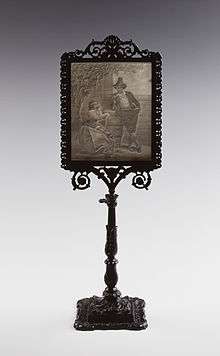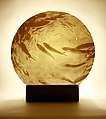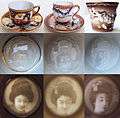Lithophane
A lithophane (French: lithophanie) is an etched or molded artwork in very thin translucent porcelain that can be seen clearly only when back lit with a light source.[1][2][3] It is a design or scene in intaglio that appears "en grisaille" (in gray) tones.[1][2][3]

- For the moth genus, see Lithophane (moth)
A lithophane presents a three-dimensional image – completely different from two-dimensional engravings and daguerreotypes that are "flat".[1][2][3] The images change characteristics depending on the light source behind them.[1][2][3] Window lithophane panel scenes change throughout the day depending on the amount of sunlight.[1][2][3] The varying lightsource is what makes lithophanes more interesting to the viewer than two-dimensional pictures.[1][2][3]
The word "lithophane" derives from Greek "litho", which is from "lithos" which means stone or rock, and "phainein" meaning "to cause to appear" or "to cause to appear suddenly".[2] From this is derived a meaning for lithophane of "light in stone" or to "appear in stone" as the three-dimensional image appears suddenly when lit with a back light source.[1]
History
European lithophanes were first produced nearly at the same time in France, Germany, Prussia, and England around the later part of the 1820s.[2][4][5] Many times historians credit Baron Paul de Bourging (1791–1864) with inventing the process "email ombrant" (pottery decorating) of lithophanes in 1827 in France.[2][3][4][5] Robert Griffith Jones acquired Bourging's rights in 1828 and licensed out to English factories to make them.[2][3] The English factories sometimes used the name "lithophane" for specimens of ordinary "email ombrant."[2][3] Some say however it was Georg Friedrich Christoph (1781–1848) of Prussia that actually perfected the true lithophane process in 1828.[2][4][5] Others say the technique was developed in Berlin and other parts of Germany by such manufacturers as Berlin porcelain (Königlichen Porzellan-Manufaktur or Porzellanmanufactur).[2][3][3][4][5] This is why sometimes lithophanes are referred to as "Berlin transparency."[2][3][4][5] There is a well known mark of Ad'T' on lithophanes from Rubles, near Melun in France. It is thought to be the mark of Baron A. de Tremblay, however some scholars on the subject think he only made earthenware and not true lithophanes and the mark belongs to a yet unknown source.[3]

Many historians argue that the inspiration for the idea came originally from China nearly a thousand years before in the Tang Dynasty.[2] According to the scholar R. L. Hobson during the Ming Dynasty the Chinese produced bowls "as thin as paper" with secret decorations (an hua) in them.[2] According to W. Hodgson she describes some Chinese biscuit porcelains as looking like "little screens with landscapes in relief" which resemble white porcelain that is obtained in Switzerland.[2] Other potential precursors to the European lithophanes come from the Chinese Song Dynasty.[2] Qingbai wares had translucency with carved and molded designs of flowers, fish, and birds.[2] Japanese lithophane tea sets are referred to as "dragonware" and were popular for GI trading in Japan during World War II.[2]

In the early part of the 20th century many lithophane investigators were making connections between the European 18th and 19th century ceramics and the Chinese porcelains.[2] In France they used the term "Blanc de Chine" in the 18th century to designate a highly translucent Chinese porcelain,[2] now called Dehua porcelain. Porcelain factories in France, Germany and England mimicked the Chinese "Blanc de Chine" in the 17th and 18th centuries.[2] These same factories then started to make lithophanes in the early part of the 19th century.[2] The technical and aesthetic inspirations for European lithophanes can be seen coming from Chinese works, however the exact relationship between the two remains elusive to this day.[2] However there is no known lithophane plaque produced anywhere in China prior to 1800.[2]
Lithophanes were made by specialized European craftspeople beginning as an image carved in warm wax on a glass plate.[1][6] This was then backlit and carved.[6] Sometimes the carving table was near a window and had a mirror below the table to provide constant light for carving.[6] A modeler would duplicate the image on a flat wax plate carving relief and intaglio.[1][6] Where the wax was carved thinnest more would shine through.[1][6] Of course where the wax was carved thickest then there was less light shone through.[1][6]
A plaster gypsum mold was cast from the wax.[3][4][5] It was sometimes cast in metal for the production of multiple molds.[4][5] The casts were removed from the molds and then fired to about 2300 degrees Fahrenheit.[2][4][5] The porcelain would include around 66% kaolin, 30% feldspar and 4% soapstone.[4][5] It turned out that up to about 60% of the porcelains would warp or crack in the kiln causing them to become useless.[4][5] Finished lithophanes are somewhere between one sixteenth of an inch thin to almost a quarter inch (1.5 to 6mm) thick.[2][4][5]
Lithophanes were produced in Austria, Belgium, Bohemia, Czechoslovakia, Denmark, England, France, Germany, Ireland, Italy, Norway, Portugal, Russia, Sweden, and Wales in the 19th century.[7] Lithophanes by the hundreds of thousands were made in the middle of the eighteen hundreds by such firms as Wedgwood in England, Meissen porcelain in Dresden, and Belleek in Ireland.[7] Lithophanes were produced then in the United States as well, however not nearly as much as in Europe.[7] Popular subjects of lithophanes were religious themes, portraits, genre scenes, literature ideas such as stories from the Bible, and masterpieces.[1][7] Some lithophanes even commemorated events such as the opening of the Eiffel Tower in 1889.[2]
Lithophanes were in various formats from plaques to be hung in windows to candle shields.[2][3][8][9] They were also in fireplace screens, night lights, tea warmers, and match boxes.[2][3][8][9] Many were pieces of bottoms of beer steins, mugs and cups.[2][3][8][9] Some were souvenir ornaments of erotica images.[2][8][9] They were even in lanterns and lamps.[2][3][8][9] Rare miniature lithophanes are parts of doll house furnishings.[2][8][9]
According to Henry Barnard, Samuel Colt's first biographer, Colt ordered and had installed on his new home ("Armsmear") in Hartford, Connecticut dozens of lithophanes he purchased in Berlin in 1855 and 1856.[10][11][12] Colt probably got the idea from the 1851 Great (Crystal Palace) Exhibition in London or the New York Great Exhibition of 1853 or in a Prussia visit in 1854.[10][11][12] Scenic views and portraits were for the public and private rooms of Colt's wife.[10][11][12] Inspirational panes were for the windows of Colt's upstairs bedroom.[10][11][12] Lithophanes of humorous nature were put in the windows of Colt's billiard room of his new home.[10][11] One of particular interest was of the Battle of Trafalgar.[10][11][12] Others were of Stolzenfels Castle on the Rhine River and a view of Koblenz.[10][11][12] Barnard described the lithophanes as "a veritable art gallery."[10][11][12] A photograph of Armsmear taken between 1857 and 1861 shows over one hundred lithophanes.[10] A photograph of 1907 shows the lithophanes of Armsmear still in place.[10] Many of Colts surviving lithophanes are currently at the Wadsworth Atheneum Museum of Art.[10]
Samuel Colt had 111 lithophanes made of his likeness from a photograph for wide distribution in 1855.[10][11][12] In this lithophane portrait he is sitting at a small desk holding a "Belt Pistol" in his right hand and has a directional compass in his left hand.[10][11][12] One of these he sent to Senator Thomas J. Rusk who responded in a letter of 3 January 1856 when he received it,
My Dear Friend,
It was with sincere pleasure that I received this morning by Adams Express yours of the 28th of last month and the accompanying box. The likeness is indeed excellent and I thank you most warmly for it.
Respectfully yours,
Modern lithophanes
More recently lithophanes have been made with the use of CNC machines and 3D printing, starting with the shades of a black and white photograph used to generate a heightmap surface, which is then used to mill or print a solid object from a semi-translucent material.
Gallery
 Modern porcelain photographic lithophane on stand
Modern porcelain photographic lithophane on stand Porcelain lampshade featuring photomontage artwork
Porcelain lampshade featuring photomontage artwork Porcelain lampshade featuring photomontage artwork in daylight
Porcelain lampshade featuring photomontage artwork in daylight Old japanese cups, showing lithophane of ladies
Old japanese cups, showing lithophane of ladies





References
Notes
- "The Blair Museum of Lithophanes - What is a Lithophane". Archived from the original on 2008-06-15. Retrieved 2008-07-28.
- Carney, pp. 4-14, 19, 21, 23-27, 29, 32-36, 38, 42-55, etc.
- Savage, pp. 180-181
- Jean-Baptiste 1858, pp. 187-191
- Jean-Baptiste 1884, pp. 691-692
- Klimaszewski, Nicolai, Ceramics Monthly, "Hand-Carving Lithophanes", October 2007, Volume 55, Issue 8.
- Lise, pp. 82, 83, 88, 136, 168-169
- Great Exhibition 1852, p. 1150
- New-York Exhibition 1853, p. 142
- Samuel Colt's porcelain transparencies - Magazine Antiques, April, 2006, 169 no. 4, pp. 106-115
- The Home, The Arm, and the Armory of Samuel Colt, a Memorial by Barnard, Henry, New York 1866
- Houze, p. 230-238
Bibliography
- Carney, Margaret, Lithophanes, Schiffer Publishing 2007, ISBN 978-0-7643-3019-3
- Houze, Herbert G., Samuel Colt: Arms, Art, and Invention, Yale University Press 2006, ISBN 0-300-11133-9
- Jean-Baptiste-Ambroise-Marcellin Jobard, Les nouvelles inventions aux expositions universelles (Brussels and Leipzig, 1858), volume 2.
- Jean-Baptiste-Ambroise-Marcellin Jobard, Title unknown, L'intermédiaire des chercheurs et curieux, vol. 17, no. 597 (November 25, 1884).
- Lise Baer et al., Along the Royal Road: Berlin and Potsdam, 1848. Original at Library of Congress.
- Great Exhibition of the Works of Industry of all Nations (London, 1852), vol. 3. Original at Library of Congress.
- Official Catalogue of the New-York Exhibition of the Industry of all Nations, rev. ed. (New York, 1853). Original at Library of Congress.
- Savage, George et al., An Illustrated Dictionary of Ceramics, Van Nostrand Reinhold Co., New York 1974, ISBN 0-442-27364-9
Additional
Additional reference pertaining to Samuel Colts lithophanes are located at the Connecticut Historical Society – Samuel Colt papers, in particular box 7.

